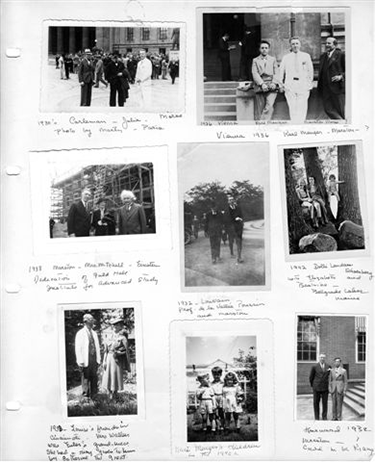The above photograph (ca. 1958) of Marston Morse (1892–1977), Professor in the School of Mathematics, and his wife Louise is a rare image from one of two albums compiled by Louise Morse over seven decades. It is unusual in that it includes Louise herself. Louise was often the one behind rather than in front of the camera. Her two packed volumes reveal the Institute’s mathematical community at leisure. Enhanced with newspaper clippings and carefully annotated with names and dates, the albums, which have been promised to the Shelby White and Leon Levy Archives Center, are a treasure trove of snapshots taken at the annual gatherings of Institute Faculty, Members, Visitors, and their families held by Marston and Louise in their home.
Marston and Louise Morse were known as generous and engaging hosts, inviting groups of twenty mathematicians at a time on four separate occasions throughout the year. Louise made a point of knowing the name of every guest so that she could introduce newcomers. After her husband’s death, she continued the tradition with annual parties that coincided with the annual Marston Morse Lectures each spring.
The couple met mid-Atlantic in 1936 when Marston spotted Louise and her three friends dancing onboard ship. He had joined the Faculty of the Institute for Advanced Study the year before, taking his place alongside James W. Alexander, Albert Einstein, Oswald Veblen, John von Neumann, and Hermann Weyl. Born in Waterville, Maine, Morse was a talented pianist who had to choose between a career in music or mathematics. He is recognized for defining a new branch of mathematics (differential topology) known as Morse theory. In 1936, he was on his way to Europe to lecture in mathematics. Louise, who grew up in Hanging Rock, Ohio, had just graduated in nursing from Johns Hopkins and was taking a six-week trip with her friends. Although Morse was a good deal her senior, she accepted his invitation to dance. They were married in 1940 (she was twenty-eight, he was forty-seven), and took up residence at 40 Battle Road—which became a second home to those mathematicians from around the world visiting the Institute.

A cherished member of the Institute community, Louise celebrated her one hundredth birthday in June. Her memories reach back to teas with Elizabeth Veblen, cocktails with the von Neumanns, and dinners with the Oppenheimers at Olden Farm. Shortly after her marriage, she found herself seated next to Albert Einstein at a dinner hosted by Abraham Flexner and his wife Anne Crawford Flexner in New York City. Although Einstein joked that he didn’t know what to say to a new young bride, it was Louise who recalls being at a loss for words. Later she and Einstein would share a common cause in deploring the unequal treatment of African Americans in America and in Princeton. Louise is well-known as a loyal supporter of the Princeton Committee of the NAACP Legal Defense and Educational Fund, which paid tribute to her contributions and commitment last October.
In May, Louise donated a first edition of Abraham Flexner’s autobiography I Remember to the Shelby White and Leon Levy Archives Center. Louise pasted various personal mementos into the book, including personal correspondence between the Flexners and the Morses between 1940 and 1956. The book is inscribed by the author in honor of the birth of Louise and Marston’s daughter Julia.
